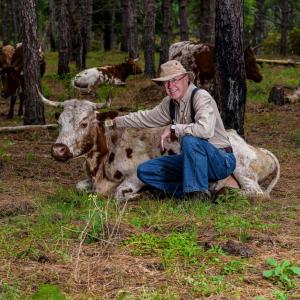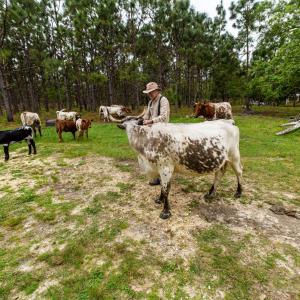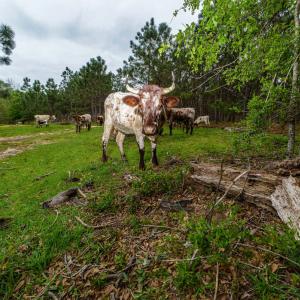Under New Management
Extension collaboration explores conservation grazing
Story by Nathan Gregory • Photos by Kevin Hudson
The benefits of prescribed burns on Jim Currie’s longleaf pine land in Hancock County were short-lived. He needed something extra to keep the understory vegetation from growing back so quickly.
After doing some research on the history of Pineywoods grazing, he had what he describes as an “aha” moment. In May 2017, he attended a Pineywoods Cattle Registry and Breeders Association meeting, where he met his future cattle partner.
“I began building fences, and he brought some of his Pineywoods herd over in spring of 2018,” Currie recalls. “The first 10 heifers that were produced are mine, and now some of them are having calves. We brand the cattle to tell them apart but run the herd together.”
That was when Currie began using a combination of burning and targeted grazing.
“It has been transformational,” he says. “From an aesthetic point of view, the pine savannas are more open, and the wildlife have responded accordingly. We have never seen the number of turkey and deer as we are seeing presently.”
For more than 20 years, Currie has relied on guidance from forestry specialists with the Mississippi State University Extension Service to ensure the best management of his timber and habitat.
“Extension brought me into forestry. After I returned to Pass Christian in 1997, I answered an Extension ad in the newspaper for a short course called Introduction to Woodland Management,” he says. “There, I met a friend from grade school, Judd Brooke. Judd and his parents have been putting together a large block of timberland in north Hancock County since 1952. The Brookes sold me some of their land.”
He notes MSU Extension’s close ties to the Mississippi Forestry Association and county forestry associations.
“When we at the Hancock/Harrison County Forestry and Wildlife Association are looking for programs to present to our membership,” Currie says, “we often turn to Extension’s list of seminars. That list comes with specialists who are more than willing to come and present the program.
“One of the more impressive things that Extension does is hold a producers’ commodity conference every year at its regional research facilities,” he explains. “In this way, the producers can give feedback to Extension on research needs that are evolving.”
Currie may soon gain more insight into conservation grazing strategies thanks to Dr. Eric Sparks, director of the Coastal and Marine Extension Program based at the MSU Coastal Research and Extension Center in Biloxi.
Sparks and a team of collaborators are developing a research plan to examine whether goat and cattle grazing can be a less intrusive alternative or supplement to other land-management restoration techniques, such as prescribed fire, mechanical removal, or chemical treatments.
Sparks visited Currie’s land to develop his research and hopes to parlay the research plan into grant funding for a full-fledged project. MSU Extension and the Mississippi-Alabama Sea Grant Consortium are partnering with multiple National Estuarine Research Reserves along the U.S. Gulf Coast.
“This is one of the most fun projects I’ve worked on,” Sparks said. “I have a personal interest in it because I grew up raising goats, but there’s tons of interest in this from landowners and natural resource managers. The potential benefits of conservation grazing need to be researched more but seem very promising so far.”








